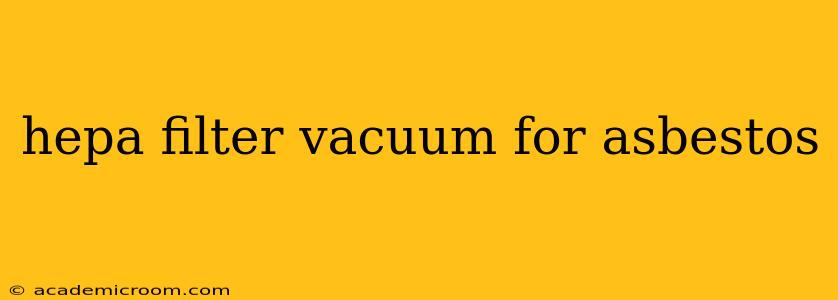Asbestos exposure is a serious health concern, and proper cleanup is crucial. Using the right equipment is paramount, and a HEPA filter vacuum cleaner plays a vital role in safely removing asbestos-containing materials. This guide will delve into the specifics of choosing and using a HEPA filter vacuum for asbestos removal, addressing common questions and concerns.
What is a HEPA Filter and Why is it Important for Asbestos Removal?
HEPA stands for High-Efficiency Particulate Air. HEPA filters are designed to trap at least 99.97% of airborne particles with a size of 0.3 microns or larger. Asbestos fibers are incredibly small, and many are within this size range, making HEPA filtration essential for preventing their release into the air during cleanup. Breathing in asbestos fibers can lead to serious lung diseases like asbestosis, lung cancer, and mesothelioma. Therefore, a vacuum with a certified HEPA filter is crucial to minimize the risk of exposure during asbestos abatement.
What Makes a Vacuum Suitable for Asbestos Removal?
Not all HEPA filter vacuums are created equal. When choosing a vacuum for asbestos removal, several key factors must be considered:
- HEPA Filtration Certification: Ensure the vacuum has a HEPA filter certified by a reputable organization like the U.S. Environmental Protection Agency (EPA) or a comparable international standard. Look for the certification label on the filter itself. This certification guarantees the filter meets stringent standards for particle removal.
- Vacuum Type: HEPA filter vacuums suitable for asbestos removal often come in either wet/dry or dedicated industrial models. Wet/dry vacuums can handle both dry debris and liquid, offering versatility. Industrial vacuums are built for heavier-duty tasks and generally offer more robust construction and higher suction power.
- Sealed System: The vacuum should be designed with a sealed system to prevent leakage of asbestos fibers during operation. Look for a vacuum that prevents air from bypassing the HEPA filter.
- Suction Power: The vacuum needs sufficient suction power to effectively remove asbestos fibers from surfaces. Higher suction power generally leads to more efficient cleaning.
- Disposal: A suitable vacuum should make it easy and safe to dispose of collected asbestos waste. The dust bag or collection container should be easily removable and sealed for safe disposal according to local regulations.
Choosing the Right HEPA Filter Vacuum:
The choice of vacuum cleaner for asbestos removal often depends on the scale of the project. For small-scale projects, a high-quality wet/dry vacuum with a certified HEPA filter may suffice. For larger or more complex asbestos abatement jobs, a dedicated industrial vacuum with a powerful motor and a larger dust collection capacity is recommended. Always consult with a qualified asbestos abatement professional to determine the best equipment for your specific situation.
H2: Can I use a regular vacuum cleaner with a HEPA filter for asbestos removal?
While some regular vacuums have HEPA filters, they are generally not suitable for asbestos removal due to potential leaks in the system and insufficient suction power. Using an unsuitable vacuum could increase the risk of asbestos fiber dispersal into the air. Always prioritize a vacuum specifically designed and certified for asbestos abatement.
H2: How do I dispose of the asbestos waste collected by the vacuum?
Disposal of asbestos waste is strictly regulated. You MUST follow all local, state, and federal regulations. Typically, asbestos waste needs to be placed in sealed, labeled containers and disposed of at a designated hazardous waste facility. Improper disposal poses serious health and environmental risks. Never dispose of asbestos waste in regular trash bins.
H2: What safety precautions should I take when using a HEPA filter vacuum for asbestos removal?
Always wear appropriate personal protective equipment (PPE), including a respirator certified for asbestos, protective clothing, gloves, and eye protection. Proper ventilation is also crucial to minimize the risk of exposure. It's best to consult with an asbestos abatement professional for guidance on handling asbestos safely and legally. Remember, DIY asbestos removal can be very dangerous and could result in serious illness.
H2: What are the different types of HEPA filter vacuums available?
Several HEPA vacuum types cater to different needs and scales of asbestos removal. These include portable, backpack, and industrial vacuums, each offering distinct features and capabilities. The choice depends on the asbestos removal project's specifics.
Conclusion:
Successfully removing asbestos requires expertise and the right equipment. A certified HEPA filter vacuum is a critical tool in minimizing asbestos exposure risks. Prioritizing safety and following proper procedures are essential for the health and well-being of everyone involved. Remember, if you suspect asbestos in your home or workplace, always consult a qualified professional for assessment and abatement. This information is for educational purposes only and does not constitute professional advice.
